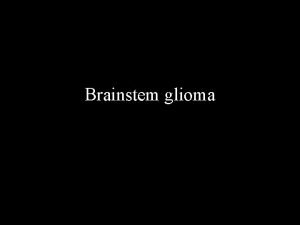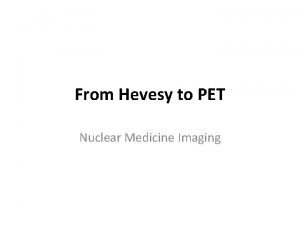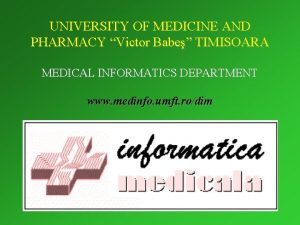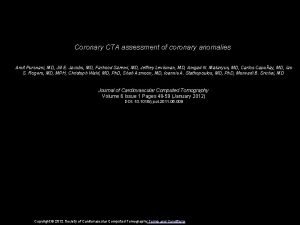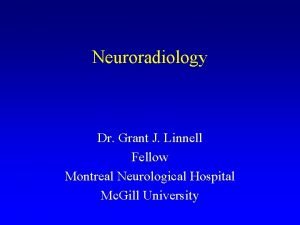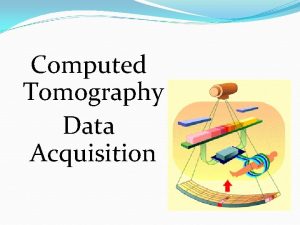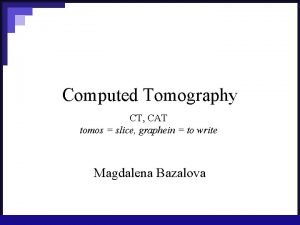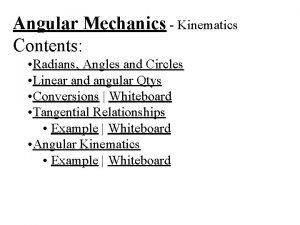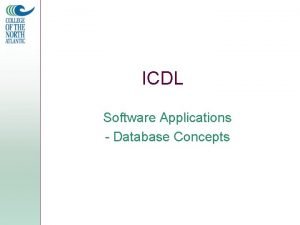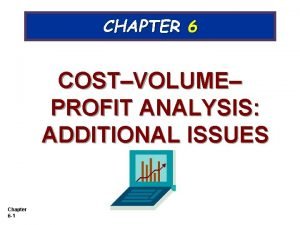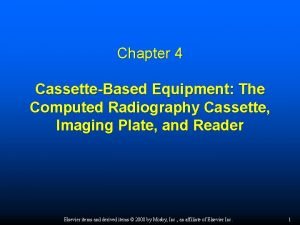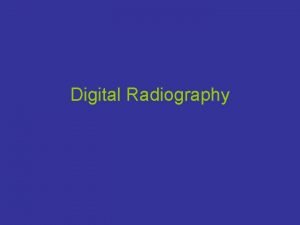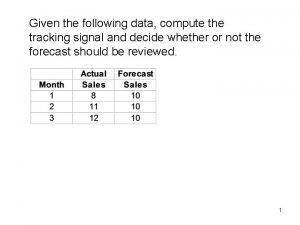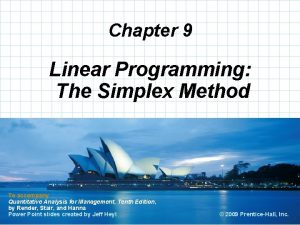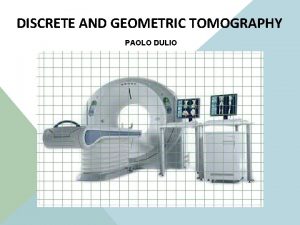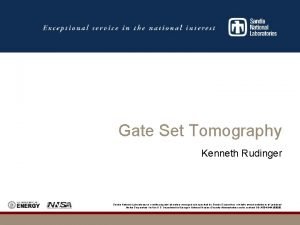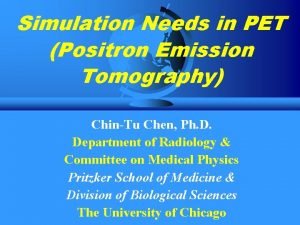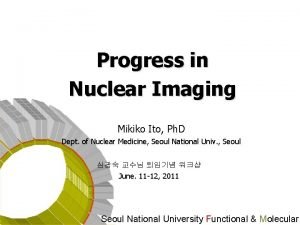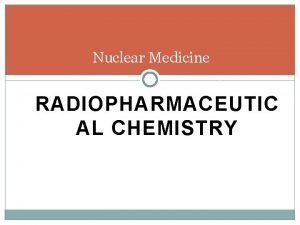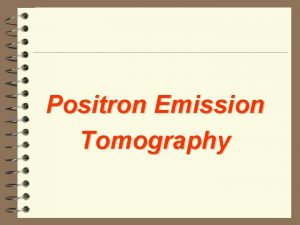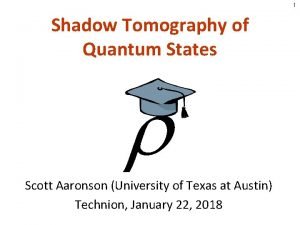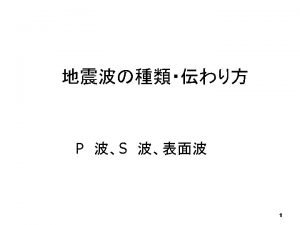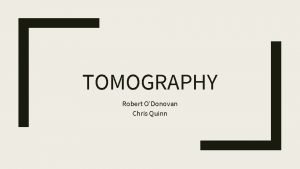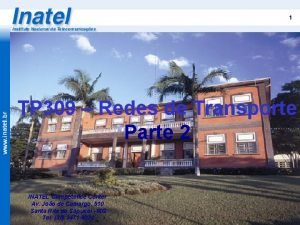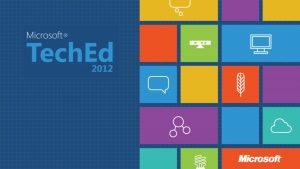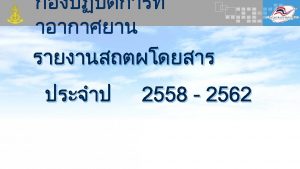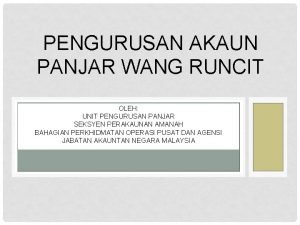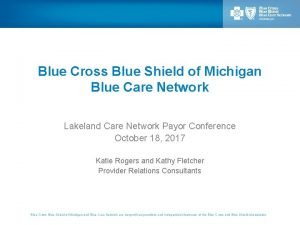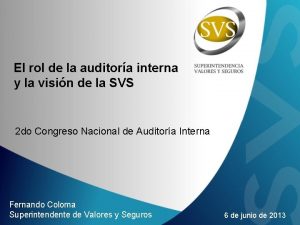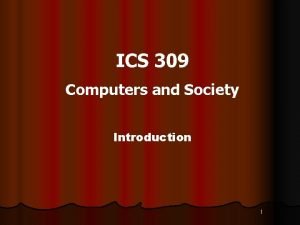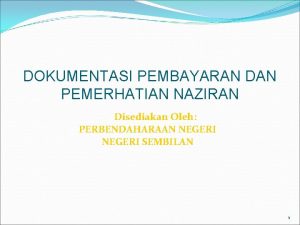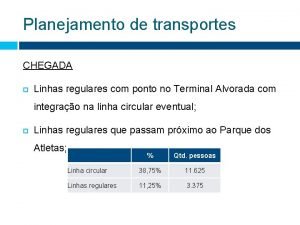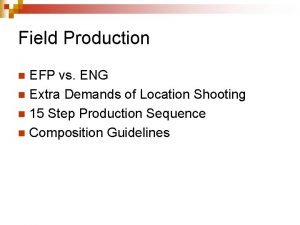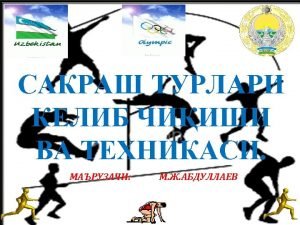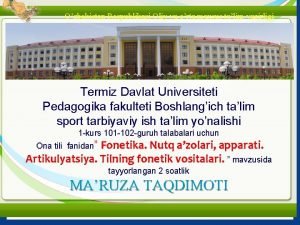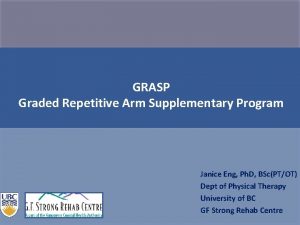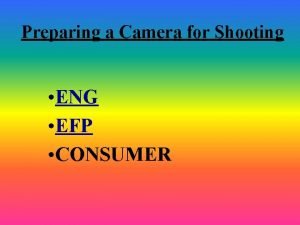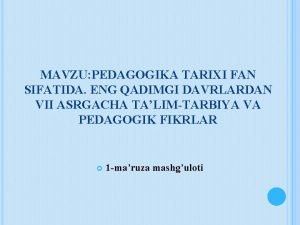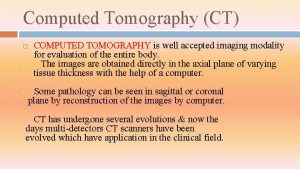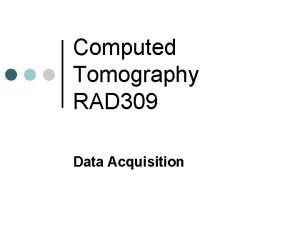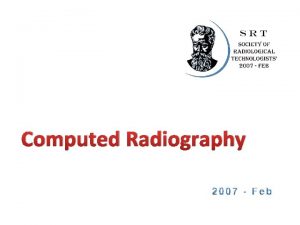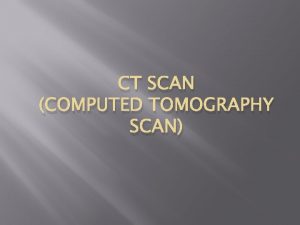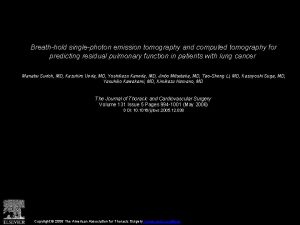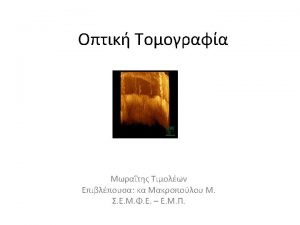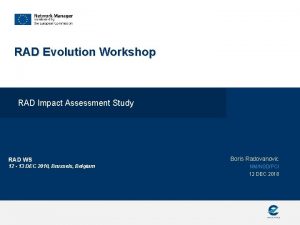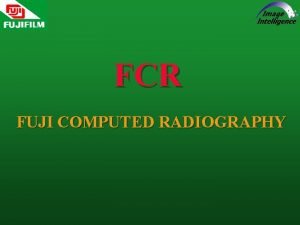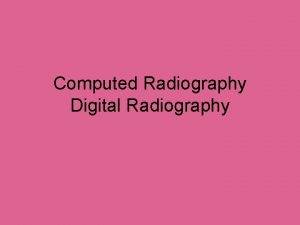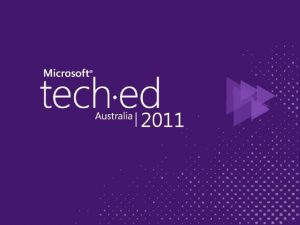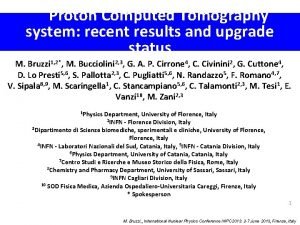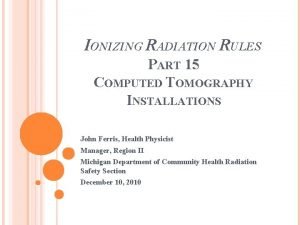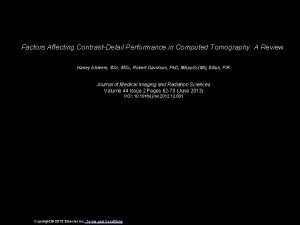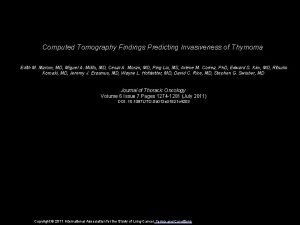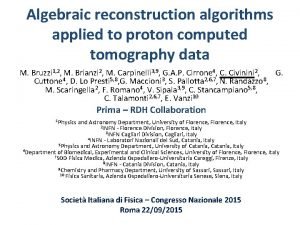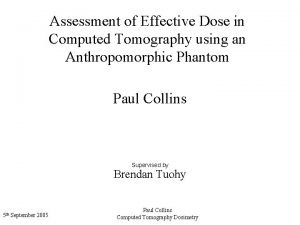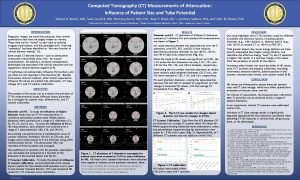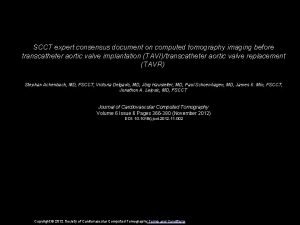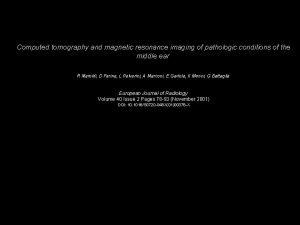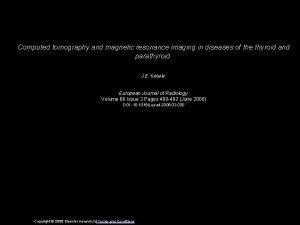Computed Tomography RAD 309 Dr Eng Sarah Hagi

















































- Slides: 49

Computed Tomography RAD 309 Dr. Eng. Sarah Hagi MSc (USA) Ph. D (UK)

Course n n n Dr. Mawya Khafaji Book Practical TLD’s Grading: n Continuous Assessment (40%) n n Midterm, Quizzes, HM, Practical Final Exams (60%) n n Written (40%) Practical (20%)

Course Outline Topic Instructor History, evolution of technology , process overview S. Hagi Computer Technology and the use of Computers in Radiography Physical Principles and instrumentation of CT S. Hagi Principles of CT, Characteristics of X-radiation, CT beam attenuation, and linear attenuation coefficients S. Hagi Data Analysis S. Hagi CT generations and Spiral CT S. Hagi Components of CT Scanner, Gantry assembly (patient aperture, rotating frame, xray tube, collimator, and detectors), patient table, operator console, CT computer and workstations S. Hagi Tissue Characteristics and Hounsfield attenuation numbers application M. Khafaji Data acquisition and manipulation, image reconstruction algorithms, such as filtered back projection and transform M. Khafaji Image Quality and operating console parameters M. Khafaji Dose, technical parameters for dose measurement/possible reduction methods M. Khafaji Quality Assurance of computed tomography M. Khafaji

WEEK Begining Date Lectures Instructor 1 March 7 th Lect 1&2 S. Hagi 2 March 14 th Lect 3&4 S. Hagi 3 March 21 st Lect 5&6 S. Hagi 4 March 28 th Lect 7&8 S. Hagi 5 April 4 th Lect 9&10 S. Hagi 6 April 11 th revision S. Hagi 7 April 18 th Midterm S. Hagi 8 April 25 th Break 9 May 2 nd Lect 11&12 M. Khafaji 10 May 9 th Lect 13&14 M. Khafaji 11 May 16 th Lect 15&16 M. Khafaji 12 May 23 rd lect 17&18 M. Khafaji 13 May 30 th Lect 19&20 M. Khafaji 14 June 6 th revision M. Khafaji 15 June 13 th revision M. Khafaji 16 June 20 th Final M. Khafaji

Computed Tomography RAD 309 Practical Second Semester, Third Year Conducted by Clinical Instructor 1. Visit to different hospitals to see components of available generations of CT in the field of Medical Imaging 2. Group discussion-Physical principles and instrumentation involved in CT 3. Group discussion-characteristics of x radiation, CT beam attenuation, linear attenuation coefficient 4. Tissue characteristics and Hounsfield attenuation numbers application, demonstrated on display console-to show hounsfield numbers of different tissue 5. Data acquisition and manipulation, image reconstruction algorithms, such as filtered back projection and transform 6. Group discussion on problem based learning of data acquisition and manipulation, image reconstruction algothirms 7. Demonstration of components including functions, CT scanner, Gantry assembly, patient table, operator console, CT computer and workstation 8. Demonstration -Operation of Scan console, to enter patient data, selection of scan parameters 9. Demonstration -Operation of Display console manipulate scan data and post processing such as Multiplanar reformatting. .

Introduction n A method of examining body organs by scanning them with X rays and using a computer to construct a series of crosssectional scans along a single axis n Acquiring and reconstructing, thin cross section on the basis of measurement of attenuation

Tomography Since 1900 s n n n Several researchers were interested in a specific layer or section to represent a single slice of the body on radiographic film Tomo- section in Greek Transverse section were developed by Watson (transverse= cross section) But with not enough details, clarity, not fully utilized as a clinical tool Conventional Tomography n Provides 2 D view of a 3 D distribution of an object (x, y, z) with superimposition of all structures Disadvantages: n depth information is lost n overlapping structures may interfere with diagnosis, and small differences in contrast is lost n No quantitative

Method The idea is based on simple principles of projective geometry: n x ray source on one side of the object and the film on the other (diagonal) n Source and detector move at constant rate opposite directions n Source and detector distance, rate of motion, adjusted such that objects in the imaging plane project to the same relative location on the film. n Objects out of the plane, blurred Tomography had been one of the pillars of radiologic diagnostics until the late 1970 s

Goals of CT To overcome superimposition of structures n To improve contrast n To measure small differences in tissue contrast n n CT came to solve the problems of tomography and conventional radiography, image reconstruction from projections

Solution Transmitting a collimated beam through a cross section of the body n Detectors, measuring small differences in tissue contrast n Computer that allows data manipulation and reconstruction n

The Birth of CT 1972 n Nobel Prize in 1979, Sir Godfrey Hounsfield & Alan Cormack “ computer assisted tomography” n Solved the problem of conventional n

Image Reconstruction History 1917 Radon proved that it was possible to mathematically build an image from large number of its projections (different angles) Has been widely used in many fields n Images of the body can be reconstructed from a large number of projections from diff. locations n

Theory n n n When radiation passes through an objects, some of it is absorbed, scattered attenuation (which we will discuss in details in another lecture) Attenuation measurements is the basis of CT imaging Radiation passes through each section in a specific way (depending on the tissue properties/characteristics) onto a detector that sends signal to a computer for processing Computer produces clear, sharp image of internal structure of the object This doesn’t happen spontaneously, there algorithms mathematical computations to put the projections together and produce the image data

Cont. All trials to make use of image reconstruction techniques in radiology were not successful n Technology barrier, computers n In 1967 Hounsfield applied reconstruction techniques to produce the first clinically useful scanner (used only for brain imaging) n

Who is He?

Production of X-Ray “fast-moving electrons slam into a metal object, x-rays are produced” n Roentgen experimented with electron beam in a vacuum tube surrounded by cardboard n He noticed light/glowing spots on fluorescent screen n Next, started to place objects b/w the screen and the tube n Finally he placed his wife’s hand in front of the screen

Historical Developments 1895 1896 -98 Wilhelm Roentgen Henri Becqurel and the Curie’s 1946 Discovery of X-ray Discovery of natural radioactivity Nobel Prize (1 st physics) Mathematical basis and concepts of image reconstruction Discovery of NMR principles 1972 1973 Invention of CT Producing MR imaging Hounsfield and Cormack Lauterber and P Mansfield 1979 2003 Nobel Prize in Medicine Nobel in Physol. & Medicine Hounsfield and Cormack Lauterber and Mansfield 1901 1917 Roentgen Radon Flex Bloch and Edward Purcell

Hounsfields Invention n Sir Godfrey N. Hounsfield, DSc, the father of computed tomography, died on August 12, 2004 at the age of 84

First CT n n n n the "EMI-Scanner“ Limited to brain acquired the image data in about 4 minutes (scanning two adjacent slices) images from these scans took 2. 5 hours to be processed by algebraic reconstruction techniques on a large computer scanner required use of a water-filled tank with a pre-shaped rubber "head-cap" at the front, which enclosed the patient's head 160 parallel readings through 180 angles, each 1° apart, with each scan taking a little over five minutes a single photomultiplier detector, and operated on the Translate/Rotate principle

Basics of CT n n Measurement of attenuation of a cross section of the body System uses the data to reconstruct a digital image of the cross section n n Each pixel in the image represents mean attenuation of a voxel (boxlike element) Attenuation measurements: quantifies the fraction of radiation removed in passing through a given mount of material of thickness x

Cont Different names in the past 30 years: n Computerized transverse axial scanning (tomography) n Computer assisted tomography n Computerized axial tomography (CAT) n But the final name is CT n

CT Process Overview n The formation of CT image by CT scanner three steps: data acquisition, image reconstruction, and image display, manipulation, storage, and recording.

Data Acquisition n Collection of x ray transmission measurements n After passing through patient they fall onto detectors n Detector measures the attenuation value Reconstruct an image, enough data needed (transmission measurements) Data collection scheme: Example n tube & detector move in a straight line (translate) across body part (from left to right); after collecting number of transmission measurements they rotate 1 degree and start again bt from right to left Translate-rotate-stop-rotate (repeated 180 times) 180° n More efficient scanning schemes were developed n n n

Image Reconstruction n n After enough transmission measurements (detector) Sent to the computer for processing Computer (uses mathematical techniques to reconstruct the CT image) Reconstruction algorithms (example: algebraic reconstruction technique) Need: minicomputer and microprocessors for performing the function/ or array processors for calculations.

Image Display/Manipulation/Storage/Recording n n n After image reconstruction Image displayed on CRT (cathode ray tube), best for a gray scale image These monitors are on the console allowing the technologist (operator console) and radiologist (doctors console) Manipulation: transverse axial images can be reformatted into coronal , sagital, and paraxial sections. / and three dimensional processing Storage: magnetic tapes and magnetic disks and optical storage.

How CT Scanners Work Turn on power of scanner n Perform a quick test to make sure scanner is working properly n Place the patient in the scanner opening/ setup depending on exam n Technical factors are setup by the technologist at the console n

What happens when x-ray passes through the patient? n n n Attenuated and measured by the detector X ray tube and detectors are hidden inside the gantry of scanner and rotate around patient during scanning Detector converts x ray photons into electrical signals (analog), which must be converted into digital (numerical) for input on computer Computer makes the image reconstruction process Reconstructing an image is in numerical form and must be converted into electrical signal so it can be displayed on a television monitor for viewing Image can be stored on magnetic tapes or optical disks and recorded on x-ray film

Computers n n A computer performs wide range of tasks Image reconstruction to storage, recording, digital transmission to remote locations Use in radiology, one of the reasons is film-less hospitals Advantage of computers: can process, store, retrieve, and communicate information quickly and accurately

What is a Computer System n n n A machine for solving problems High-speed electronic computational machine that accepts information in the form of data and instructions (though an input) and process the information by performing arithmetic and logic operations using a program stored in its memory Results of the process can be displayed/stored/recorded/transmitted

Three Components Hardware: physical component of the machine, input devices, output devices, processing hardware n Software: instructions to solve the problem n User/operator : design hardware/software and operate the machine n

Software The hardware receives instruction from the software ( instruction = written step by step how to solve the problem/programs) Three types: n n Systems software- start up, coordinate the activities Applications software- programs we run or use on the computer Software development tool- programming languages

History of Computers n n n n 1642 the abacus, counting machine 1694, calculating machine (multiplication and division) 1890 – punch card machine Rapid development till Howard Aiken’s MARK 1 (large electromechanical calculator) 1951, UNIVAC – universal automatic computer (first commercially available) Today's computers are fifth generations Generation – a period of significant technical developments in hardware and software

Computer Generations 1 st: 1951 -1958, large, slow, heat during operation, housed in an air-conditioned room 2 nd: 1959 -1963, solid-state devices (transistors and magnetic cores) for internal memory, less heat, smaller, less power for operation 3 rd: 1963 -1970, integrated circuit, silicon chips/use of magnetic disks for storage (several programs processed at the same time) , faster, smaller, more reliable

Generations 4 th: 1971 -1987, 1000’s of integrated circuits on chip 5 th: 1987 -date, gallium based circuitry instead of silicon, parallel processing, many processors are used to operate on data at the same time n These computer developments affected development in other technologies and medical imaging is a important example

Classification Depending on their processing capabilities n Supercomputers-large, high capacity, processes data at extremely high speed n n Use: weather forecasting, oil exploration, scientific modeling CRAY 2, one of the fastest computers available today

Cont. n Mainframe Computers- large, high speed computation, large memories, terminals enable multiple users access to primary memory (use in banks, universities) Millions of Instructions Per Second n multiple operating systems, and thereby operate not as a single computer but as a number of virtual machines. In this role, a single mainframe can replace dozens or even hundreds of smaller servers.

Cont. n Minicomputers- mid level computer built to perform complex computations while dealing with high level of input and output for users connected via terminals (multi user computer) much smaller than mainframes (fill a room) n minicomputers will be discussed more when we talk about CT components

Cont. n Microcomputers- small digital computers/ personal computers, built so all circuitry is placed in a single chip or multiple circuit boards (microprocessor, central processing unit CPU) n n Microprocessor is a digital integrated circuit that processes data, controls work of microcomputer The processing capability is related to number of bits, binary digits(0 and 1)used to represent data

Cont. n n 8 -bit (28)processor = represents 256 numbers 16 -bit (216) processor = 65, 536 numbers can be represented 32 -bit(232) 2 types of computers Digital and Analog n Digital operate on digital data (discrete units) and analog operate on continuous physical quantities n Digital computes are most common, they operate on digital data through arithmetic and logic operations, used in radiological applications, its important that we understand the nature of digital systems

Numbering Systems Decimal numbers system = based on ten n 0, 1, 2, 3, 4, 5, 6, 7, 8, 9 n Any number written must be a sum of these digits multiplied by 10 x n Example 321 n Unit/tens/hundreds/thousands/ten thousands/hundreds thousands/million n

Binary numbers system based on factors of 2 n Only two values 0 and 1 n 1 2 4 8 16 32 n Writing 7 and 10 in binary n 0111 and 1010 n 64 128

Converting Decimal to Binary n Example 133 , list 1 to 128 n Binary to Decimal n Example 01010110 , count 8 n Put 0’s and 1’s under numbers then add n

Other Numbers Since binary numbers can be long, octal and hexadecimal systems n Octal 8 digits 0 1 2 3 4 5 6 7 n Hexadecimal 16 n Example: convert binary to octal 010110100, group them n 010, 100 100=4; 110=6; 010=2 so the octal number is 264 n

Why n A binary digit, a bit, which is a single binary number, n n 4 binary bits (0. 5 byte) 8 binary bits (1 byte) 16 binary bits (2 bytes) 32 binary bits (4 bytes) n Binary numbers, grouped in 8 digits called bytes n Byte is a location in the memory, memory capacity is measured in bytes

Why n When we enter information on computer, the characters we use are converted into binary codes, two famous ones are ASCII and EBCDIC

Data Communications Hardware: modem a device that converts digital data to analog signals and converts analog signals to digital data to be transmitted and received n Multiplexer allows many computers to share communication line n Network , more on communication n

Computers in Radiology 1955, to calculate radiation dose distribution in cancer patients n Mathematical approaches in radiology n Two categories: imaging and no imaging n

Imaging Information from the patient needs processing n Digital image processing techniques n Digital images: digital radiography, digital fluoroscopy, MRI, CT n

Non-imaging n n n Radiology information system (RIS), like patient admission, billing, film library, word processing. . An electronic system for archiving, transmitting, viewing, and manipulating images (Picture Archiving and Communication Systems PACS) HIS (hospital information system) Mechanical view boxes are being replaced by workstations workstation = powerful stand alone computer with high graphic capability
 Computed tomography of the head
Computed tomography of the head Positron emission tomography
Positron emission tomography Radiology timisoara
Radiology timisoara Journal of cardiovascular computed tomography
Journal of cardiovascular computed tomography Hematome
Hematome Data acquisition system in ct scan
Data acquisition system in ct scan Computed tomography artifacts
Computed tomography artifacts Taon at ng pagkalimbag halimbawa
Taon at ng pagkalimbag halimbawa Funksiyaning eng katta va eng kichik qiymatlari
Funksiyaning eng katta va eng kichik qiymatlari Rpm to rev/min
Rpm to rev/min A computed is a calculation that a dbms performs
A computed is a calculation that a dbms performs Contribution margin per unit formula
Contribution margin per unit formula X ray cassette construction
X ray cassette construction What is computed radiography
What is computed radiography A tracking signal is computed by
A tracking signal is computed by The zj row in a simplex table for maximization represents
The zj row in a simplex table for maximization represents Seismic tomography ______.
Seismic tomography ______. Tomography
Tomography Kenneth rudinger
Kenneth rudinger Positron emission tomography
Positron emission tomography Positron emission tomography
Positron emission tomography Positron emission tomography
Positron emission tomography Positron emission tomography
Positron emission tomography Shadow tomography
Shadow tomography Seismic tomography
Seismic tomography What is tomography
What is tomography Indicativo 309
Indicativo 309 Ssis 309
Ssis 309 309 90
309 90 Rekupan
Rekupan What is the word
What is the word Blue care network e referral
Blue care network e referral Ncg 309
Ncg 309 Ics-309
Ics-309 Tunai panjar maksud
Tunai panjar maksud 309 series
309 series Elaun makan dan elaun harian
Elaun makan dan elaun harian Es 9 pag 309
Es 9 pag 309 Linha 309 central alvorada
Linha 309 central alvorada Avesto
Avesto Efp vs eng
Efp vs eng Carl emil petersen frit land tekst
Carl emil petersen frit land tekst Good afternoon class
Good afternoon class Ilgarilanma va aylanma harakatda tezlik va tezlanish
Ilgarilanma va aylanma harakatda tezlik va tezlanish Yugurib kelib uzunlikka sakrash referat
Yugurib kelib uzunlikka sakrash referat Fonemaning eng muhim belgisi
Fonemaning eng muhim belgisi Janice eng
Janice eng 2015 dse english paper 2 questions
2015 dse english paper 2 questions Eng shooting
Eng shooting Pedagogika tarixi fan sifatida
Pedagogika tarixi fan sifatida
